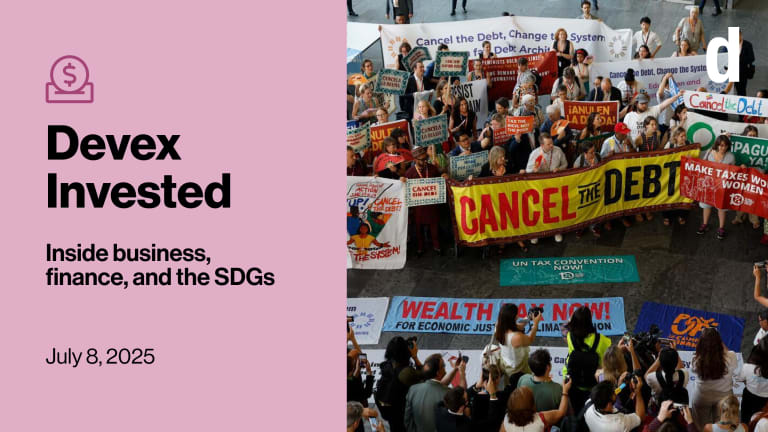
Low- and middle-income countries, or LMICs, are spending money on debt repayments at the expense of key development areas such as health. That was one of the key discussion points that came from the Fourth International Conference on Financing for Development, or FfD4, in Sevilla, Spain, in July. Here, experts urged governments to view spending on health as an essential investment in their economic future.
On the sidelines of FfD4, Kalpana Kochhar, director of development policy and finance at the Gates Foundation, spoke with Devex President and Editor-in-Chief Raj Kumar about the economic theory that healthier people are more productive, earn more, and ultimately, through taxation, generate higher revenue and healthier economies for governments.
“There are going to be some [people-centered] investments — health, education, social protection — that have huge societal returns, but maybe not big financial returns,” Kochhar said. “Health may not be a ribbon-cutting moment. But it is fundamental.
“[Put] people first,” Kochhar added. “[Recognize] that without human capital investment, you’re not going to get anywhere. We talk about jobs, employment, and growth being paramount. Who’s going to drive that if you don’t have healthy, productive human capital?”
According to the U.N. Trade and Development, over 3.4 billion people live in countries where more money is spent on debt repayment than on education or health, and 61 low-income countries are spending 10% of their revenues on paying interest alone. More than half of LICs, including Afghanistan, Ecuador, and Djibouti, are in debt distress or at high risk of being so.
“When you have scarcity of money and you have all these competing and really important investments ranging from health all the way to climate mitigation, can we get smart about how we allocate finance according to economic-first principles, risk and return profiles?” Kochhar posited.
With that question in mind — and coinciding with the launch of a report by the U.N.'s expert panel on debt on breaking the cycle of debt distress and unlocking sustainable financing for LMICs — Devex spoke with experts from international finance institutions and government representatives on the sidelines of FfD4 to learn how investments in health could deliver progress in debt repayment.
Innovative approaches to simultaneously tackle health and debt levels
As highlighted by Kochhar, at the basic level, simply channeling more money into the likes of primary health care, disease prevention, and community health contributes to economic growth. There are, however, other ways of tackling health and debt challenges simultaneously, and “how we invest in and how we finance health” is something that should be considered by finance ministers, said Nicole Kearse, principal legal counsel and head of the sovereign finance sector at the African Legal Support Facility.
There are, for example, a new generation of debt-for-development swaps, which channel some of the expensive debt service that countries are facing into investmentsin social sectors such as education, and could be applied to the health sector; debt service pauses that halt payments during crises, most notably natural disasters, and could be more widely used in response to pandemics; and development bonds, which pool financing and resources from private sector and government with a focus on specific health outcomes.
There is also the potential to work with the private sector on technology transfer, said Kearse. An example of that in action that Dr. Priya Agrawal, vice president of health equity and partnerships at MSD, shared is of Indonesia’s minister of health wanting to accelerate cervical cancer elimination via access to Gavi, the Vaccine Alliance’s human papillomavirus vaccines. Instead, they approach the private sector to invest in a technology transfer that would enable the Southeast Asian country to manufacture its own HPV vaccines at a sustainably lower price. This not only improves women’s health, but also creates jobs and economic gains that can help to repay long-standing debts.
Tap into development-oriented solutions that put countries in the driver’s seat
The conversation around how to address sovereign debt in a more development-oriented way is not a new one. Some of the most promising new solutions, however, are coming from developing countries themselves and emphasize country-led development and reform plans.
The World Bank and International Monetary Fund’s three-pillar approach, for example, details structural reforms governments could make to enhance their economic growth and mobilize domestic resources; means of obtaining other forms of international financial support and ensuring net positive financing flows; and tools for reducing debt servicing burdens. The guidance was modeled on the Bridge proposal — authored last year by teams at the Finance for Development Lab and Columbia University’s Initiative for Policy Dialogue — which commits countries to national investment plans, multilaterals to providing further financial support, and other creditors to continued provision of capital.
Then there is the African Financing Stability Mechanism, a regional financial stability mechanism designed to refinance debt. It was endorsed earlier this year at the African Union Conference on Debt, which also saw the announcement of a declaration outlining African priorities for restoring debt sustainability.
These solutions underscore a point made by Axel van Trotsenburg, senior managing director at the World Bank, during FfD4 that countries must lead investment in their health care systems and complement it with international support. “Governments have to invest, not sporadically, but continuously, so we see basically international support as an important complement, but not a substitute for health expenditures,” he said.
Focus on the impact
Investors should have health outcomes top of mind rather than focusing on program costs and activities, said MSD’s Agrawal. That pivot is something she believes is starting to happen. “What I'm hearing at this conference here in Sevilla is a real switch from thinking about health being funded to health being invested in, and I think that’s actually a massive mindset shift because you go from ‘How much money can I give?’ to ‘How much value can I unlock?’” she explained. “What does that actually mean tangibly on the ground? You talk about return on investment; therefore, you measure the impact rather than activity and inputs.”
That impact — be it lower levels of preventable mortality, higher rates of vaccine coverage, or reduced disease prevalence — can then help to attract private sector investment, said Kevin Chika Urama, chief economist and vice president of economic governance and knowledge management at the African Development Bank. “If there’s one thing that we need to take home, [it] is the need to accelerate and refocus on public sector financing in order to help mobilize private sector financing,” he said, explaining that the private sector doesn't go into risky environments and investing in health is one way to de-risk. “When you don’t have good health, when you don’t have good governance and institutions, and you have political risks, the private sector will not be there.”

Build trust as an integral part of all efforts to tackle debt
When it comes to exploring any of these options, restructuring debt in innovative ways, and investing in health, only one thing is truly needed, van Trotsenburg told Devex — trust.
This has historically been lacking between debtor countries and creditors, FfD4 attendees highlighted throughout the week, listing issues with hidden transaction fees, high interest rates, and a general lack of transparency around repayment processes.
To remedy this, attendees suggested both creditors and countries get better at sharing data and commit to transparency, and that creditors work with other ministries besides finance, including those of health and education.
However, trust is waning as existing tools and solutions have proven too slow to deliver meaningful results. The promise of more financing continues to fall short of materialization. For any debt reform mechanism to succeed, countries need to be able to trust that the international financial system will deliver the financing necessary for them to develop and implement strong, health-focused development plans that can break the cycle of debt dependency.




